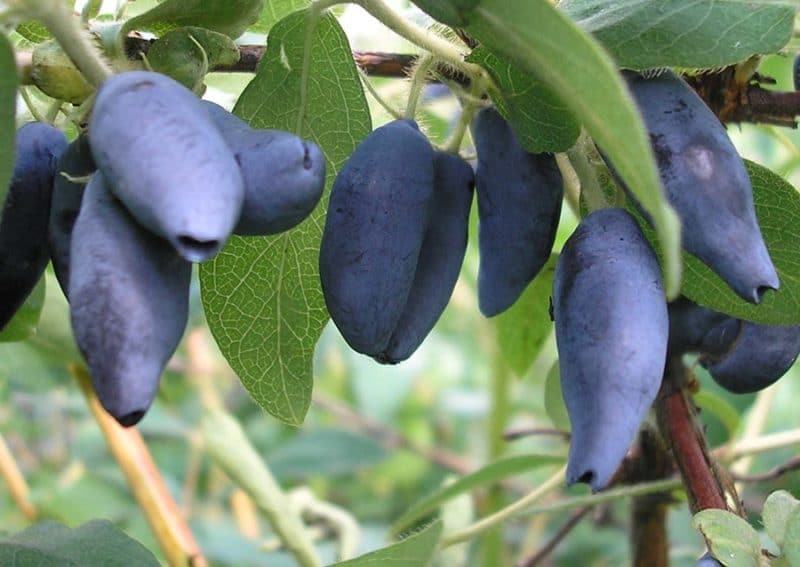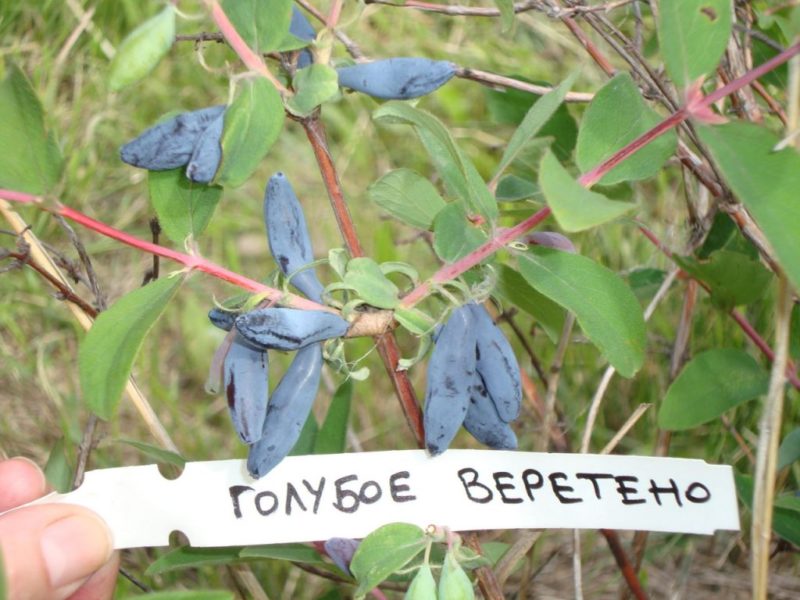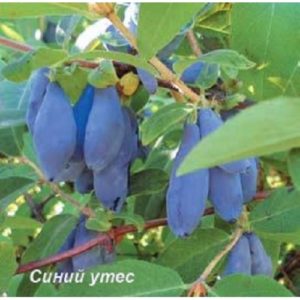The largest honeysuckle, new varieties
Honeysuckle is a shrub plant that is especially popular among gardeners. In addition to its neat appearance and beautiful flowering, which allow you to beautifully decorate the site, the plant is distinguished by rich and long-lasting fruiting. Delicious oblong blue berries of edible varieties contain many useful substances and have a beneficial effect on the body. Let's look at varieties and new varieties of honeysuckle with large berries, and also find out what to look for when choosing.
The largest fruited varieties of edible honeysuckle

There are several centers for breeding edible honeysuckle in Russia: Siberian, South Ural, Pavlovsk, Moscow. The varieties they developed retain the original qualities of the mother plants and are grown in different climatic zones.
Breeders are eradicating shortcomings in the form of low yield, fruit shedding, bitter taste, and most importantly, small fruit. Now many modern varieties can boast large berries.
Blue spindle

The variety was bred by the Siberian Breeding Center and registered in 1989. The botanical description and distinctive characteristics are as follows:
- Shrub 1-1.5 m high with a rounded crown of medium density. The branches are green, thin, directed upwards. In the sun's rays they acquire a brown tint.
- The leaves are large, dark green, oblong with pointed ends.
- The flowers are small yellowish bells. They are located on branches in pairs. Flowering earlier, during the spring thaw.
- The fruits are large, up to 3 cm long and weighing up to 1.5 g. They are lumpy and resemble a spindle. The skin is dense, dark blue, covered with a waxy coating. The taste is sweet and sour; during drought, bitterness appears. Maturation uneven - from the beginning to the end of June.
The bush begins to bear fruit at 4-5 years of age. Productivity – 1.2-2 kg per adult plant.
Reference. Varieties-pollinators For Blue spindle – Blue Bird, Kamchadalka, Cinderella, Tomsk.
The advantages of the variety are high frost and drought resistance. The disadvantages include the crumbling of ripe berries. Yield loss can be up to 15%.
Amphora
Amphora is a variety of the Pavlovsk fruit nursery, registered in 1998. It is characterized by the following features:
- Bush 1.3-1.5 m high with a round and dense crown. The skeletal branches are straight, massive, pubescent, burgundy in color. The shoots are upright, raspberry-colored.
- The leaves are oval, bright green. The surface is fleecy, uneven, slightly compacted.
- The flowers are yellow-greenish and shaped like bells.
- The fruits are about 2 cm long and weigh from 1.3 g to 3 g. The berries are pitcher-shaped. The skin is dense, elastic, blue in color with a small waxy layer. The fruit tastes sweet and sour with a slight hint of bitterness. Ripen in mid-late June.
Fruiting begins 3 years after planting the bushes. Productivity – up to 2 kg per bush.
Reference. Pollinator varieties – Violet, Bazhovskaya, Viola, Morena, Nymph.
The variety has good frost resistance and is immune to diseases and pests, characterized by uniform ripening of berries. The main disadvantage is the sour taste of the fruits or their absence when the bush grows in the shade.
Kamchadalka
Kamchadalka is the result of the work of the Siberian Center.Registered in 1984 and recommended for cultivation in regions with temperate climates.
The variety has the following characteristics:
- The shrub is medium-sized and compact, up to 1.5 m high. The crown is dense, not spreading. The skeletal branches are large and even. The shoots are short, light green in color.
- The leaves are small, elongated, dull green. The surface is matte.
- The flowers are small and yellow. Collected in inflorescences of several pieces.
- The fruits are 2-2.6 cm long, weighing 1-1.4 g. The berries are oblong, bluish-blue in color with a bloom. The skin is thin, smooth and dense. The fruits are juicy, sweet and sour in taste, aromatic. Ripen in the second half of June.
The yield is 1-1.8 kg, but can reach 3 kg, depending on the climate and quality of care.
Reference. Pollinators – Blue spindle, Tomichka, Cinderella, Parabelskaya.
The variety is resistant to frost and drought, but does not tolerate frequent and sudden temperature changes.
Nymph

Nymph - a culture bred by the Pavlovsk Center. Included in the State Register in 1998 and recommended for cultivation in any climate.
Description of the variety of large-fruited honeysuckle:
- A bush up to 2.5 m high with a slightly spreading, dense crown. The skeletal branches are straight, thick, with flaky bark, brownish-sandy in color. Young shoots are powerful, green, covered with villi.
- The leaves are large, oval, dark green.
- The flowers are large, dirty white. Collected in inflorescences of 2 pieces.
- The fruits are large, up to 3 cm long, weighing 0.8-1.1 g. The berries are distinguished by their spindle-shaped shape and lumpy blue surface with a bluish bloom. The skin is moderately thick and dense. The fruits taste sweet. They have a pleasant aroma. Ripen in mid-late June.
The plant begins to bear fruit 3-4 years after planting.Under favorable conditions, the yield is stable and amounts to 1.3-2 kg per bush.
Reference. Pollinators – Amphora, Lazurnaya, Pavlovskaya.
The variety is characterized by frost resistance, good adaptability to different climatic conditions, and resistance to diseases and pests.
New varieties of honeysuckle with large berries
Blue Cliff, Ussulga, Yugana - new varieties bred in the Siberian center on the basis of the Bakcharsky fruit nursery. Breeders solved problems of increasing fruit size, increasing yield and improving taste.
Reference. The basis of Siberian varieties are samples of Kamchatka and Primorsky honeysuckle with sweet fruits.
Characteristic features of Siberian varieties are high frost resistance and orientation towards a cold, sharply continental climate. Successful cultivation has been noted in central Russia.
blue cliff

The variety was bred in 1987. After that, it was subject to state variety testing for another 20 years.
An objective assessment of the variety was carried out, identifying the most valuable qualities for zoning and introduction into agricultural production.
blue cliff has the following characteristics:
- The bush is compact, up to 1.3 m high, with a slightly spreading oval crown of medium density.
- The leaves are elongated, oval, rich bright green.
- The flowers are small, cream-colored.
- The fruits are large, weighing 2-3 g. The berries are elongated oval, dense, blue with a bloom. The dessert taste is sweet and sour. The fruits ripen in the first half of June.
The yield is stable, high - up to 3-4 kg per bush. The fruits do not fall off, are not damaged when torn off, and are well transported.
Ussulga
The newest variety and one of the favorites of the Siberian center in terms of large-fruitedness, taste and quality of fruits:
- Shrub up to 1.8 m high. The crown is oval in shape with straight branches and numerous strong shoots.
- The leaves are oblong, green.
- The flowers are small, yellowish in color.
- The fruits weigh up to 2.5 g, are oval, with a lumpy surface, bluish-violet in color with a rich waxy coating. The taste is sweet and sour without astringency. Ripening in mid-June.
The plant reaches fruiting maturity by the 4th year of cultivation. Maximum yield is observed after 10 years. The yield is high and stable - from 2 to 4.5 kg.
Yugana

The variety was bred in 2010. It is characterized by the following distinctive features:
- Shrub up to 1.5 in height and up to 2 m in diameter. The crown is of medium density and hemispherical in shape.
- The leaves are large, oval, dark green. The surface is smooth, glossy. The leaves are slightly pubescent on the reverse side.
- The flowers are large, yellowish, with a delicate scent. Collected in inflorescences on the tips of shoots or in leaf cavities.
- The fruits weigh up to 2.3 g, are oval, dark purple in color with a waxy coating. The taste is dessert, sweet and sour with a honey-plum flavor. Ripening in mid-June.
The average yield is 3.4 kg, the maximum is up to 6.5 kg per plant.
How to choose a large honeysuckle
To choose and buy the best variety of large-fruited honeysuckle, it is important to consider the following features:
- Maturation period. Early varieties that ripen in the second decade of June include Vostorg, Blue Spindle, Kamchadalka, and Blue Cliff. Mid-season varieties that ripen in the third decade of June are Amphora, Bakcharsky giant, Yugana, Nymph.Of the late varieties that ripen by the beginning of July, the Giant's Daughter, Bazhovskaya, is distinguished.
- Resistance to diseases and pests. Such features are characteristic of the Blue Spindle, Kamchadalka, and Amphora.
- Shattering. This is a specific characteristic of honeysuckle that is often considered a disadvantage. Among the non-shattering varieties, Yugana, Kamchadalka, Amphora, and Blue Rock are distinguished.
- Taste qualities. The most prized dessert varieties are the sweet ones. Among the varieties of large-fruited honeysuckle, Nimfa, Yugana, Siny Utes, Vostorg, and Bazhovskaya are distinguished by such taste qualities.
- Productivity. A stable, rich harvest (more than 3 kg per bush) is observed in the varieties Blue Cliff, Yugana, Daughter of the Giant, Bakcharsky Giant, and Ussulga.
Large-fruited varieties differ in berry weight. There are varieties with large fruits weighing 1-1.5 g (Blue Spindle, Kamchadalka, Cinderella). The largest fruits of honeysuckle are Blue Cliff, Delight, Giant's Daughter, Bakcharsky Giant. The average weight of the berries is 2-3 g.
Conclusion
Honeysuckle is a tasty and healthy berry that is increasingly gaining popularity among gardeners. Selection work is continuously carried out around the world to improve the taste and agrotechnical properties of the plant. Domestic selection centers have been especially successful in this. A large number of large-fruited, dessert, non-shattering varieties with a high and stable indicator have been bred productivity.